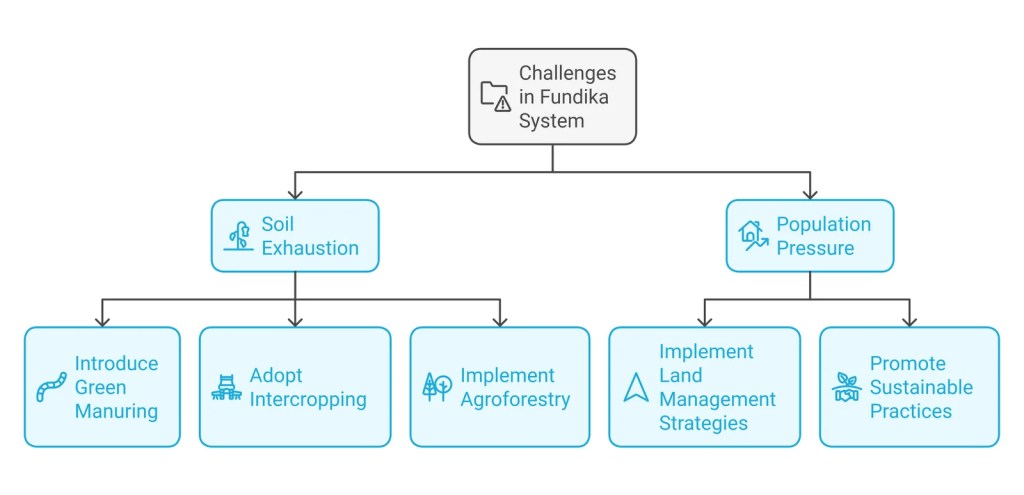The Fundika system of agriculture, also known as the “grass-mound” system, is a traditional farming method practiced by the Mambwe-speaking people in Zambia. This system evolved due to population pressure and the depletion of tree resources, which made the Chitemene system less viable. The Fundika system is a testament to the adaptability and resilience of traditional agricultural practices in response to environmental and social changes.

How the Fundika System Works
- Mound Formation:
- Towards the end of the rainy season (around May and April), farmers create mounds of grass covered by earth on previously fallowed sites. This process involves selecting a grass patch so that the covered grass can serve as manure.
- Grass Manuring:
- The grass within the mounds rots during the dry season, enriching the soil with organic matter. This natural fertilization process helps maintain soil fertility without the need for chemical fertilizers.
- Planting:
- At the start of the next rainy season (October/November), the mounds are leveled, and crops such as millet, maize, pumpkins, and myungu are planted. Millet is the main staple food crop, often interspaced with other crops to ensure a diverse harvest.
- Crop Rotation:
- After the first harvest, stubbles are collected and covered with soil to create new mounds for the second year. This process allows for continuous cultivation and maintains soil fertility through grass manuring and crop rotation.
Advantages of the Fundika System

- Sustainable Soil Fertility:
- The use of grass as manure helps maintain soil fertility without the need for chemical fertilizers. This practice ensures that the soil remains productive over the long term.
- Conservation of Trees:
- Unlike the Chitemene system, Fundika does not rely on cutting down trees, thus preserving the forest. This approach helps prevent deforestation and promotes environmental sustainability.
- Support for Large Populations:
- The system can support larger populations settled on a permanent basis due to its sustainable practices. This is particularly important in areas with high population density.
Challenges and Improvements

- Soil Exhaustion:
- Continuous cultivation can lead to soil exhaustion. Introducing green manuring crops can help improve soil quality and fertility. Farmers can also adopt practices such as intercropping and agroforestry to enhance soil health.
- Population Pressure:
- As population increases, the demand for land and resources also rises, posing a challenge to the sustainability of the system. Implementing land management strategies and promoting sustainable agricultural practices can help address this issue.
Conclusion
The Fundika system of agriculture is a sustainable and resilient farming method that has adapted to the changing environmental and social conditions in Zambia. By utilizing natural resources efficiently and preserving the environment, this traditional system offers valuable lessons for modern agricultural practices. As we continue to face global challenges such as climate change and population growth, the principles of the Fundika system can inspire innovative solutions for sustainable agriculture worldwide.
Discover more from Online Exam Prep
Subscribe to get the latest posts sent to your email.

 Pexels.com<\/a>","created_timestamp":"0","copyright":"","focal_length":"0","iso":"0","shutter_speed":"0","title":"woman sitting in front of macbook","orientation":"0"}" data-image-title="Mastering the Art of Learning: The Best Study Techniques for Success" data-image-description="
Pexels.com<\/a>","created_timestamp":"0","copyright":"","focal_length":"0","iso":"0","shutter_speed":"0","title":"woman sitting in front of macbook","orientation":"0"}" data-image-title="Mastering the Art of Learning: The Best Study Techniques for Success" data-image-description=" Pexels.com<\/a>","created_timestamp":"0","copyright":"","focal_length":"0","iso":"0","shutter_speed":"0","title":"cheerful multiethnic students with books sitting near university","orientation":"0"}" data-image-title="Looking for effective ways to prepare for your exams? Check out these 10 expert tips that can help you stay organized, focused, and motivated throughout the study process." data-image-description="
Pexels.com<\/a>","created_timestamp":"0","copyright":"","focal_length":"0","iso":"0","shutter_speed":"0","title":"cheerful multiethnic students with books sitting near university","orientation":"0"}" data-image-title="Looking for effective ways to prepare for your exams? Check out these 10 expert tips that can help you stay organized, focused, and motivated throughout the study process." data-image-description="